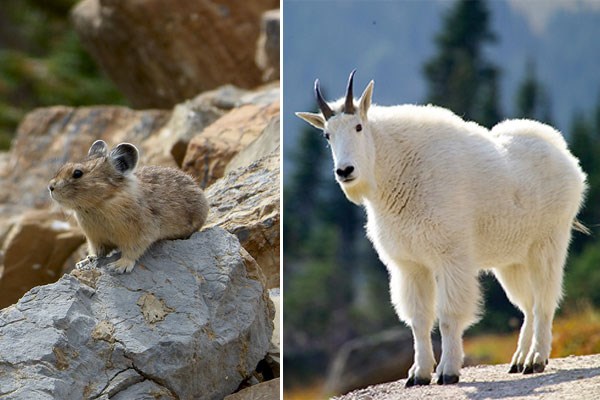
Pika: NPS/Lisa Bate; Mountain Goat: NPS
Concern about wildlife in Glacier National Park's alpine and subalpine is growing. High country habitats are highly vulnerable to changes brought about by climate change, yet, little is known about how these changes may affect the wildlife that live near the tops of Glacier's mountains.
In recent years, mountain goat and pika population declines were documented in areas outside of Glacier, but resource managers within the park lacked baseline information to track changes to these priority species. To address this need for baseline data, the High Country Citizen Science Project was established in 2008. Citizen science has proven to be an effective way to conduct wildlife monitoring on spatial and temporal scales not normally possible, especially given the limited availability of funds for trained biologists. This information is then used to enable resource managers to monitor trends over time.
Mountain Goat Surveys
Using survey equipment and protocols, citizen scientists complete one-hour surveys at one of 37 specified sites. Prior to conducting a mountain goat survey, volunteers are trained in:
• Mountain goat ecology
• Identification
• Classification of age and sex
With this information, biologists can estimate annual mountain goat populations. Using data collected since 2009, researchers are applying new statistical models to improve estimates of relative goat abundance at survey sites and to track changes in population and distribution over time.
Source: NPS DataStore Collection 7926 (results presented are a subset). To search for additional information, visit the NPS DataStore.
Pika Pellet Patrol
Citizen scientists conduct surveys by hiking to designated talus patches carrying binoculars and a smartphone and spend one hour searching for pikas, pika signs, and pika pellets. Biologists will conduct genetic connectivity analysis from the pellet samples to pinpoint key corridors in the park that could help keep the pika population connected and healthy as the climate continues to warm.
Pika Surveys
The High Country Citizen Science Project participated in a larger pika inventory and monitoring program, led by the NPS Inventory & Monitoring Network, from 2011 to 2018. In 2019, a pilot study involving a new cluster sampling design began, with the goal of gathering more detailed information about pika occupancy of known sites. The Glacier National Park Citizen Science Program provides an excellent opportunity to continue long-term pika monitoring and education by continuing a relationship with science and the public.
Last updated: September 12, 2025
